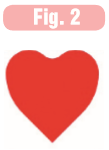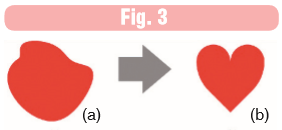Most people who start to fall in love want their love to last long or forever. Unfortunately, many people have an unexpected breakup while continuing their relationship with their partners. In this article, I would like to look at the topic of love and separation from a mechanical point of view. We will compare the subject of emotion and engineering that seems totally unrelated to each other, and find ways to prevent separation through a mechanical method.
When we see the word “love,” we often think of hearts as shown in [Fig.1-a]. When love is broken, it usually comes to mind as in [Fig. 1-b]. Most people express broken love with a heart broken vertically. Few people would think of a broken heart, either side to side or at an angle, as shown in [Fig. 1-c]. Even if it was broken vertically, there would be no heart that would break from bottom to top, rather than top to bottom, as shown in [Fig. 1-d]. In reality, materials that look the same will also have a similar behavior. If you apply force or load to a thick sheet of metal that is shaped like a heart, the panel will eventually break into two pieces starting from a crack at the middle of the heart.

When force is applied to a part of a machine, it is expressed as getting stressed. When a person suffers from some hardships, it also means that he or she is under stress. When this stress is too severe for the machine to withstand, it is usually shown to be broken with a sharp recessed head. This phenomenon is called stress concentration. In order to avoid or delay such destruction, mechanical engineering changes sharp grooves into a thick shape when it comes to machine design. If viewed as the heart, the central recessed part is converted into a round shape, as shown in [Fig. 2]. It will last longer even under the same power. The more blunt it is, the longer it will endure or not be destroyed.

When you use the heart as a symbol for the relationship between lovers, having something going on, as shown in [Fig. 3-a], the goal of the stage is to make hearts out of raw materials. When you become a lover and realize your love, you will have a heart shaped like in [Fig. 3-b]. However, this type of shape can easily crack. It is similar to the situation in which lovers are hurt by trivial things, which will accumulate, and they will end up in a big argument.

So, how can we prevent these problems? If you think of hearts as mechanical parts, you can make the sharp corners softer like [Fig. 4-a], as mentioned earlier. By making this edge softer, as shown in [Fig. 4-b], the heart will become stronger. In an extreme situation, removing the corners will make the strongest heart, as shown in [Fig. 4-c]. However, it is hard to call this a heart shape. If this represents a relationship with a lover, it would be helpful to maintain and develop a stronger relationship if trivial mistakes were allowed. If both lovers become more tolerant of each other, it would make their hearts resistant to external forces, such as [Fig. 4-a]. However, if this tolerance becomes too much and leads to indifference, then it will have the same relationship as [Fig. 4-c], and we do not call it love. Ultimately, how hearts are maintained is how they are being shaped beautifully and strongly with the right amount of tolerance and acceptance between [Fig. 1-a] and [Fig. 4-1].

If there is a problem with the machine, it can endanger the person who uses it. Similarly, when there is a problem with love, there is a danger in the person who falls in love. Whether it is a machine or the act of falling in love, there are many things that people can do to each other and this connection can easily solve the problems between two persons.

Prof. SONG, Ki Young (Dept. Mechanical Engineering)


